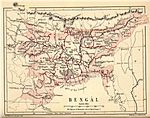Samatata

| History of Bengal |
|---|
 |
The Kingdom of Samatata (or Samata) was a kingdom in ancient Bengal, located at the mouth of the Brahmaputra river (near Comilla) in the south east of Bengal.[1] It was a vassal to the Gupta Empire.
Samatata was created following the collapse of the Mauryan Empire, sometime after the death of Emperor Ashoka in 232 BC. Not much is known about the kingdom's history, except that it was ruled by Buddhist kings in the late 7th century.
The Roman geographer Ptolemy called the kingdom Souanagoura. Two ancient Chinese travelers also mention Samatata in their travels. In the early 7th century a monk named Xuanzang called it "San-mo-tat'a" and indicates the kingdom was a Buddhist center. He gave the distance between Kamarupa and Samatata as 1300 li. He further revealed that the land was low and moist and roughly 3000 li in circuit. Samatata was visited nearly a century later by another Chinese monk, Yijing.
As of April 2010, archaeological excavations are currently underway in the villages of Wari and Bateshwar uncovering the ruins of a fortress city of Samatata.
Buddhist monument
- Asrama vihara: a Vihara, or an educational centre with residential facilities.[2]
References
- ^ AM Chowdhury (2012), "Samatata", in Sirajul Islam and Ahmed A. Jamal (ed.), Banglapedia: National Encyclopedia of Bangladesh (Second ed.), Asiatic Society of Bangladesh
- ^ https://books.google.de/books?id=9jb364g4BvoC&pg=PA71&lpg=PA71&dq=Sitakot+Vihara&source=bl&ots=4KVgtXakHO&sig=7I9Vy-ZT9lYA3aLkJmSZxP42k1c&hl=de&sa=X&ved=0ahUKEwj3qdCJ_8vNAhXL8RQKHa4DAZcQ6AEIRjAI#v=onepage&q=Sitakot%20Vihara&f=false
